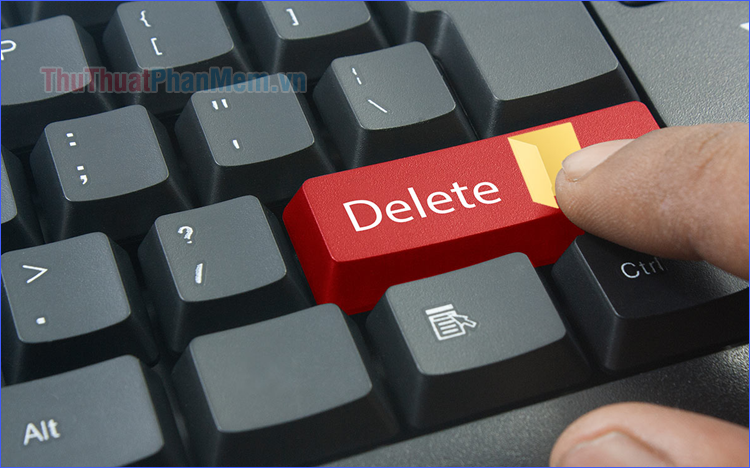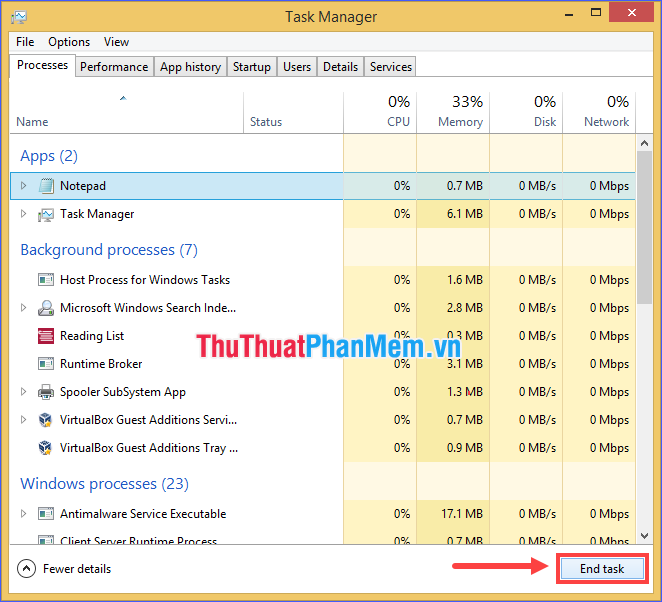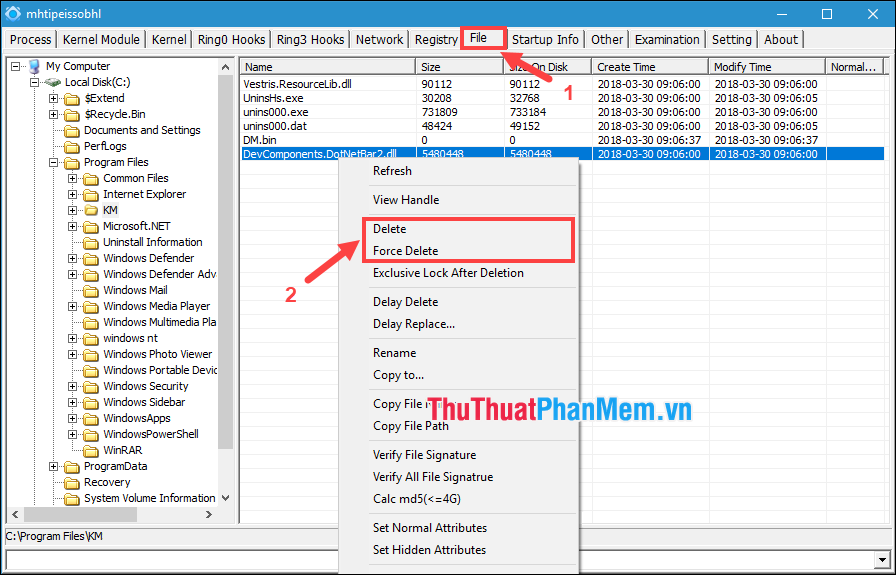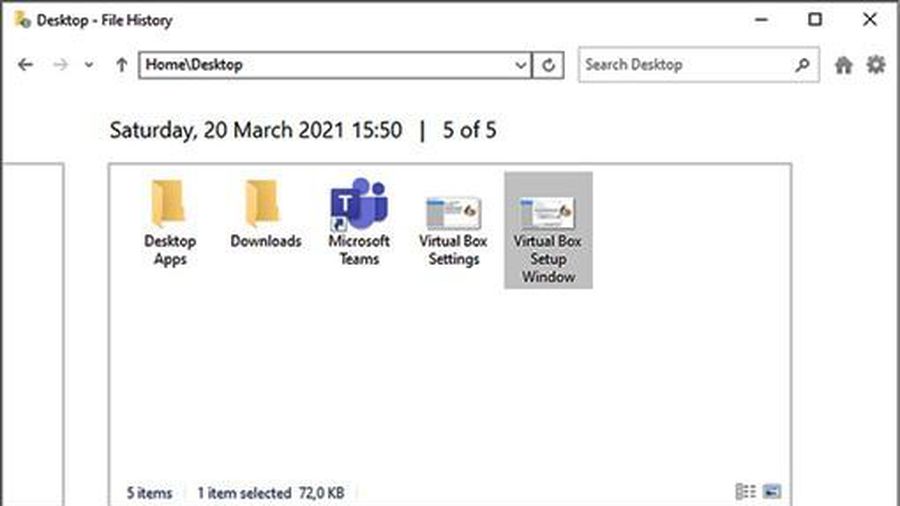How to fix files that cannot be deleted
Deleting files is a job that surely anyone using a computer has done familiarly, because after a period of use, of course there will be many files that we do not need anymore, need to leave. for a more tidy, more relieved computer. But have you ever encountered "stubborn" files that insisted on being subdued? If you can not kill them as usual, try the following ways to fix the error of not deleting files.

I. Cause the file could not be deleted
The most common, and easiest to fix, problem is that the file is being used by another program, so you can't delete it currently. The system will notify that the file is open in another program .
Another cause, though less common, but much more dangerous, is due to a virus. Therefore, when you encounter a "stubborn" file that cannot be deleted but you do not recognize it, feeling suspicious, the first way to try is to use an antivirus program to check. After ensuring that your computer is still clean and the problem is only with the system, proceed with the measures below.
II. Fix the error that the file cannot be deleted
1. Close all processes related to that file
As explained above, the file being used cannot be deleted. If the program that uses the file is an active application on the screen, simply exit the application. If it is a process running in the background, do the following:
Step 1: Press Ctrl + Alt + Del to open Task Manager .
Step 2: Switch to the Processes tab to see all active processes.
Step 3: Navigate to the process using that file and click on End task to finish. Now you can delete the file.

It is simple and the problem solving rate is relatively high, but not always successful. There are also some difficulties during execution such as not being able to identify exactly which process is using the file, or not knowing whether stopping the process will affect the system.
2. Restart
This is a "classic" approach that is always very high priority when trying to solve a nasty problem related to computers. After rebooting, all applications and processes (except system processes and allowed to start with Windows) will be shut down, the computer will return to its most relieved state, and you should return to the file. Then try to see that it can be deleted.
3. Delete the file using Command Prompt
Using the Command Prompt to delete sometimes works, and you should definitely try.
Step 1: Using the Windows Search tool, search for the keyword "cmd", the results will appear as Command Prompt . Right click on it, select Run as administrator .

Step 2: Type the following command and press Enter :
delWhere is the path to the file you want to delete.
For example, del c: usersAdminDesktoptext.txt
4. Boot in Safe Mode
This is also a solution to end the file situation used by another process.
+ With Windows 7 and earlier, as soon as the computer began to restart, press the F8 key repeatedly to open the Advanced Options Menu , then select Safe Mode .
+ With Windows 8/10, press and hold the Shift key , and while holding the key, click Power > Restart . Next, select Troubleshoot > Advanced options > Startup Settings > Restart .

After the computer restarts, press the F4 key to access Safe Mode.
5. Use third party tools
If all of these methods fail, we will need the intervention of another "outside" force. I recommend you to use PCHunter , this is a free anti-rootkit software that can help you delete even the most stubborn files.
Download: PCHunter
It's really easy to use. After installation, open the software, switch to the File tab , find the file you want to delete, right-click on it and select Delete or Force Delete .

Through the above article, I have introduced you the most effective ways to fix the error of not deleting files on the computer. It is important to note that deleting warning files on Windows can cause system and program problems, depending on the type of file you are trying to delete. So be careful if you are not sure about the possible consequences.
You should read it
- How to recover deleted files on Linux
- How to use Foremost to recover deleted files in Linux
- Trick to recover Android data is lost
- How to recover deleted data or Secure format
- How to add files to the exclusion list in Avast so as not to be deleted mistakenly
- How to recover deleted files on Microsoft Teams
- How to recover deleted files on Android phones
- How to Recover Deleted Files from Your Computer
May be interested
- How to Recover Deleted Files from Your Computer
 this wikihow teaches you how to restore a file you've deleted from your windows or macos computer. if you've only recently deleted the file, you can usually restore it quickly from the recycle bin (pc) or the trash (mac). as long as you...
this wikihow teaches you how to restore a file you've deleted from your windows or macos computer. if you've only recently deleted the file, you can usually restore it quickly from the recycle bin (pc) or the trash (mac). as long as you... - Recover deleted data with Recuva
 recuva is a software that can help you recover deleted data effectively. if you accidentally delete important data but don't know how to recover deleted data, you can use recuva to recover data.
recuva is a software that can help you recover deleted data effectively. if you accidentally delete important data but don't know how to recover deleted data, you can use recuva to recover data. - Recover deleted files from the cloud service
 assuming that in some cases you accidentally delete important files on cloud services, you should not worry too much because you can still restore these files. in the article below, network administrator will guide you how to recover deleted files on google drive, onedrive and dropbox.
assuming that in some cases you accidentally delete important files on cloud services, you should not worry too much because you can still restore these files. in the article below, network administrator will guide you how to recover deleted files on google drive, onedrive and dropbox. - How to recover deleted files in Windows 10
 you can delete unused files on your computer to increase free space, or for privacy reasons. however, during the cleaning process, you accidentally delete some important files by mistake. so is it possible to recover? here are ways that can help you fix the mistake, even of permanently deleted files.
you can delete unused files on your computer to increase free space, or for privacy reasons. however, during the cleaning process, you accidentally delete some important files by mistake. so is it possible to recover? here are ways that can help you fix the mistake, even of permanently deleted files. - How to recover, retrieve deleted files in trash
 how to recover, retrieve deleted files in trash. in the course of using the computer, you have probably encountered a case of mistakenly deleting data. if you are in that case, don't worry, because when we delete a file in windows, the file
how to recover, retrieve deleted files in trash. in the course of using the computer, you have probably encountered a case of mistakenly deleting data. if you are in that case, don't worry, because when we delete a file in windows, the file - How to recover deleted files on iCloud Drive
 how to recover deleted files on icloud drive. icloud drive is apple's cloud service that helps us transfer data in apple devices like iphone, ipod, ipad, macboook ... easily. in addition, we can also use icloud drive to create a backup of data
how to recover deleted files on icloud drive. icloud drive is apple's cloud service that helps us transfer data in apple devices like iphone, ipod, ipad, macboook ... easily. in addition, we can also use icloud drive to create a backup of data - How to Delete Undelete Files
 this is an article showing how to delete regular files that cannot be deleted on your computer. in most cases, files that cannot be deleted are being used by some program or service; you can solve the problem by starting your computer in safe mode to stop most programs and services. if the file is corrupted or the computer reports that the file cannot be found, repairing the hard disk error may fix the problem. on android phones and tablets, you can use third-party apps to delete files. however, the article does not instruct on deleting system files, as this may cause the computer to crash.
this is an article showing how to delete regular files that cannot be deleted on your computer. in most cases, files that cannot be deleted are being used by some program or service; you can solve the problem by starting your computer in safe mode to stop most programs and services. if the file is corrupted or the computer reports that the file cannot be found, repairing the hard disk error may fix the problem. on android phones and tablets, you can use third-party apps to delete files. however, the article does not instruct on deleting system files, as this may cause the computer to crash. - How to recover deleted files permanently in the trash
 sometimes you want to temporarily delete a file or a folder in the trash (recycle bin) but accidentally miss shift + delete or empty recycle bin and so all data is gone completely. however, we can still save deleted data by tips in the article below.
sometimes you want to temporarily delete a file or a folder in the trash (recycle bin) but accidentally miss shift + delete or empty recycle bin and so all data is gone completely. however, we can still save deleted data by tips in the article below. - Recover deleted files in Exchange Server 2003 (Part I)
 today we will introduce the series on recovering deleted files on exchange server 2003. this series is divided into two parts, the first part introduces how to recover data at the mailbox storage level. part two will discuss dry matter
today we will introduce the series on recovering deleted files on exchange server 2003. this series is divided into two parts, the first part introduces how to recover data at the mailbox storage level. part two will discuss dry matter - Searching for browsing history has been deleted
 just like other data on a computer, your browser history will be saved as a file. clearing your browser history simply deletes these files from your hard drive. if using file recovery measures (eg recuva software), it is possible to recover your browser history after being deleted.
just like other data on a computer, your browser history will be saved as a file. clearing your browser history simply deletes these files from your hard drive. if using file recovery measures (eg recuva software), it is possible to recover your browser history after being deleted.










 Want to sell your PC? Here's what you need to do
Want to sell your PC? Here's what you need to do Razer Ornata v2 keyboard remains a mechanical-membrane-mashup fave
Razer Ornata v2 keyboard remains a mechanical-membrane-mashup fave HP's new Omen 15 gaming laptop promises big performance in a smaller size
HP's new Omen 15 gaming laptop promises big performance in a smaller size What is Take Ownership? How to add Take Ownership to right-click Menu
What is Take Ownership? How to add Take Ownership to right-click Menu How to completely disable Windows Sync Center, stop Mobsync.exe
How to completely disable Windows Sync Center, stop Mobsync.exe How to connect Google Home to Chromecast
How to connect Google Home to Chromecast